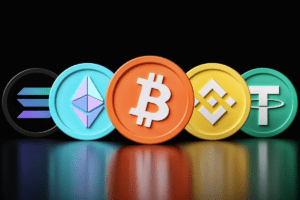Understanding Solana
Solana is a high-performance blockchain platform designed to enable fast and secure decentralized applications (dApps) and cryptocurrencies. With its innovative technology and focus on scalability, Solana’s mainnet has garnered attention in the blockchain community.
Introduction to Solana
Solana was founded in 2017 by Anatoly Yakovenko, a former engineer at Qualcomm. The platform aims to address the scalability and speed limitations faced by many blockchain networks. Solana achieves this through a combination of unique technologies and design decisions.
The Power of Solana’s Mainnet
Solana’s mainnet is the live network where transactions and smart contracts are executed. It serves as the foundation for the Solana ecosystem, supporting a wide range of applications and services.
One of the key strengths of Solana’s mainnet is its scalability. Traditional blockchain networks often struggle with limited transaction throughput, resulting in congestion and high fees during periods of high demand. Solana overcomes these challenges by utilizing a unique architecture that can handle thousands of transactions per second. This high transaction throughput is achieved through a combination of parallel processing and a Proof-of-History (PoH) consensus mechanism.
Solana’s PoH is a novel approach that enables the network to reach consensus on the order of transactions without the need for all nodes to process every transaction. This results in efficient validation and increased network throughput, allowing Solana to handle a large number of transactions in a short amount of time.
Additionally, Solana’s mainnet prioritizes security and decentralization. The platform employs advanced cryptographic techniques and robust security measures to protect user funds and ensure the integrity of the network. Solana’s security model is designed to withstand various types of attacks, providing a safe environment for users and developers.
To further enhance the Solana ecosystem, the platform offers a range of developer tools and resources. These tools simplify the process of building and deploying dApps on Solana’s mainnet, enabling developers to unleash their creativity and contribute to the growth of the ecosystem. You can find more information about Solana’s developer tools and resources in our article on solana ecosystem.
In conclusion, Solana’s mainnet is a powerful blockchain platform that offers high scalability, fast transaction processing, and robust security. Its innovative technology and developer-friendly environment make it an attractive option for individuals and organizations looking to build decentralized applications. As Solana continues to evolve and gain traction, its mainnet is poised to drive the next wave of innovation in the blockchain space.
Exploring Solana’s Mainnet
To understand Solana’s mainnet, it’s important to grasp the concept of a mainnet and explore the features and capabilities that Solana’s mainnet offers.
What is a Mainnet?
In the world of blockchain technology, a mainnet refers to the live and fully functional version of a blockchain network. It is the production-ready version where transactions are executed, smart contracts are deployed, and decentralized applications (dApps) are built. A mainnet enables users to interact with the blockchain network in a secure and decentralized manner.
Solana’s mainnet is the backbone of the Solana blockchain ecosystem. It is the network where participants can make transactions, create and deploy smart contracts, and build innovative applications. Solana’s mainnet provides a reliable and robust infrastructure for developers, businesses, and users to leverage the power of blockchain technology.
Features and Capabilities of Solana’s Mainnet
Solana’s mainnet boasts several features and capabilities that set it apart from other blockchain networks. These include:
Scalability and Speed
Solana’s mainnet is designed for scalability, offering high transaction throughput and low latency. It can process a remarkable number of transactions per second (TPS), making it one of the fastest blockchain networks in existence. The scalable nature of Solana’s mainnet is achieved through a combination of innovative technologies and consensus algorithms, such as Proof-of-History (PoH) and Tower BFT (Byzantine Fault Tolerance). These technologies ensure that Solana can handle a large number of transactions without sacrificing speed or security.
For more information on Solana’s scalability, you can refer to our article on Solana scalability.
Security and Decentralization
Solana’s mainnet prioritizes security and decentralization. It employs a unique consensus algorithm called Proof-of-History (PoH), which provides a chronological proof of events on the blockchain. PoH enables Solana to validate transactions quickly and maintain a high level of security. Additionally, Solana’s approach to security includes measures such as cryptographic techniques and regular audits to minimize the risk of vulnerabilities.
For further details on Solana’s security measures, you can explore our article on Solana’s approach to security.
Developer Tools and Resources
Solana’s mainnet offers a range of developer tools and resources to facilitate the creation of decentralized applications. Developers can leverage Solana’s software development kit (SDK), which provides the necessary tools, libraries, and documentation for building on the Solana blockchain. The SDK simplifies the development process, allowing developers to focus on creating innovative blockchain-based solutions.
To explore the available developer tools and resources, you can visit our article on Solana’s developer tools and resources.
Examples of Projects on Solana’s Mainnet
Solana’s mainnet has attracted a vibrant and growing ecosystem of projects and applications. From decentralized exchanges to decentralized finance (DeFi) platforms, various projects have been built on Solana’s mainnet. These projects leverage Solana’s speed, scalability, and security to provide efficient and user-friendly solutions.
For a deeper understanding of the projects and applications on Solana’s mainnet, you can refer to our article on Solana’s ecosystem.
Solana’s mainnet serves as a powerful foundation for developers and users alike to harness the potential of blockchain technology. With its scalability, speed, security, and developer-friendly ecosystem, Solana’s mainnet opens up a world of possibilities for decentralized innovation.
Scalability and Speed
When it comes to blockchain networks, scalability and speed are crucial factors that determine their effectiveness and usability. Solana’s mainnet addresses these challenges by providing high transaction throughput and utilizing an innovative consensus algorithm.
Solana’s High Transaction Throughput
Solana’s mainnet is known for its exceptional transaction throughput, which refers to the number of transactions a network can process within a given time frame. Solana achieves high throughput by utilizing a unique combination of technologies and design principles.
With Solana’s mainnet, users can experience transaction speeds of up to thousands of transactions per second (TPS). This is made possible by leveraging a combination of several key components:
-
Parallel Processing: Solana employs a technique called parallel processing, where multiple transactions are processed simultaneously. This approach allows for efficient use of computational resources, significantly increasing the network’s transaction capacity.
-
Proof-of-History: Solana introduces a novel feature called Proof-of-History (PoH), which provides a verifiable record of time for each transaction. By incorporating PoH, Solana eliminates the need for traditional consensus mechanisms to reach agreement on the order of transactions. This allows for faster transaction validation and subsequent block confirmation.
-
Tower BFT Consensus: Solana’s mainnet utilizes a consensus algorithm called Tower BFT (Byzantine Fault Tolerance). This consensus mechanism enables the network to achieve consensus quickly and efficiently, further contributing to its high transaction throughput.
To put Solana’s high transaction throughput into perspective, traditional blockchain networks like Bitcoin and Ethereum typically handle only a few transactions per second. Solana’s ability to process a significantly higher number of transactions makes it well-suited for applications that require fast and scalable blockchain solutions.
Solana’s Consensus Algorithm
Solana’s consensus algorithm, Tower BFT, plays a vital role in ensuring the security and efficiency of the network. Tower BFT is a variant of the classic Practical Byzantine Fault Tolerance (PBFT) consensus algorithm, designed specifically for Solana’s needs.
Tower BFT enables Solana to achieve consensus among network validators quickly and reliably. Validators in the Solana network work together to validate transactions and secure the network. Through the Tower BFT consensus algorithm, Solana ensures that all validators agree on the state of the blockchain, allowing for a consistent and secure network.
By employing Tower BFT, Solana is able to achieve fast block confirmation times, enabling near-instant finality for transactions. This means that transactions on Solana’s mainnet are confirmed and cannot be reversed within seconds, providing users with a seamless and efficient experience.
With its high transaction throughput and innovative consensus algorithm, Solana’s mainnet sets itself apart as a scalable and speedy blockchain network. These features make Solana an attractive choice for developers and businesses looking to build decentralized applications that require fast and efficient transaction processing. To learn more about Solana’s ecosystem, tokenomics, and other technical details, visit our comprehensive articles on solana tokenomics and solana scalability.
Security and Decentralization
When it comes to blockchain networks, security and decentralization are vital considerations. Solana’s Mainnet is designed with these principles in mind, utilizing innovative technologies to ensure the integrity and safety of the network.
Solana’s Proof-of-History
One of the key components that contributes to Solana’s security is its unique consensus algorithm, known as Proof-of-History (PoH). PoH is a verifiable delay function that enables the network to order transactions efficiently and establish a linear timeline of events. By utilizing this algorithm, Solana ensures that the order of transactions is accurately recorded and prevents any manipulation or tampering of the transaction history.
The Proof-of-History algorithm significantly enhances the security of the Solana Mainnet by providing a reliable and immutable record of all transactions. It ensures that the network remains resistant to attacks and maintains the integrity of the data stored on the blockchain. This innovative approach to establishing a consistent transaction history sets Solana apart from traditional blockchain networks.
Solana’s Approach to Security
In addition to the Proof-of-History algorithm, Solana employs several other security measures to safeguard the network and its participants. Solana utilizes a Byzantine fault-tolerant consensus mechanism, which means that the network can continue to operate efficiently and securely even in the presence of malicious actors or nodes.
Furthermore, Solana’s Mainnet benefits from continuous monitoring and auditing by a network of validators. Validators play a critical role in maintaining the security and decentralization of the network. They validate transactions, propose new blocks, and ensure that the network operates in accordance with the established rules. Validators are selected based on their reputation, reliability, and expertise, ensuring that the network remains robust and resistant to attacks.
By implementing these security measures, Solana reinforces the trust and confidence of its users, providing a secure environment for decentralized applications (dApps) and transactions to thrive.
In conclusion, Solana’s Mainnet prioritizes security and decentralization through the use of innovative technologies such as the Proof-of-History algorithm and a Byzantine fault-tolerant consensus mechanism. These measures ensure the integrity of the network and provide a secure foundation for the development and execution of decentralized applications. To learn more about Solana’s tokenomics and ecosystem, visit our articles on Solana tokenomics and Solana ecosystem.
Building on Solana’s Mainnet
Solana’s Mainnet provides a robust and scalable platform for developers to build decentralized applications (dApps) and projects. With its high-performance architecture and advanced features, Solana offers a range of developer tools and resources to support the creation of innovative solutions on its Mainnet.
Solana’s Developer Tools and Resources
Solana offers a comprehensive suite of developer tools and resources to facilitate the development process and enhance the capabilities of projects built on its Mainnet. These tools provide developers with the necessary infrastructure and support to unleash their creativity and build scalable applications.
One of the key developer tools provided by Solana is the Solana Software Development Kit (SDK). The SDK offers a set of libraries and APIs that enable developers to interact with the Solana blockchain and build decentralized applications. It provides the foundation for creating smart contracts, managing transactions, and integrating various functionalities into Solana-based projects.
In addition to the SDK, Solana offers a rich set of documentation and tutorials that guide developers through the process of building on the Solana Mainnet. The documentation covers various topics, including setting up a development environment, understanding the Solana architecture, and deploying smart contracts. These resources empower developers with the knowledge and guidance needed to leverage Solana’s capabilities effectively.
Furthermore, Solana hosts regular hackathons, workshops, and events to foster community engagement and encourage developers to explore the potential of building on Solana. These events provide opportunities for networking, learning, and showcasing innovative projects. By actively participating in the Solana developer community, developers can access valuable insights, collaborate with like-minded individuals, and stay up-to-date with the latest advancements in the Solana ecosystem.
Examples of Projects on Solana’s Mainnet
The Solana Mainnet has attracted a diverse range of projects that leverage its scalability and high transaction throughput. These projects span various sectors, including decentralized finance (DeFi), non-fungible tokens (NFTs), gaming, and more. Here are a few notable examples:
| Project Name | Description |
|---|---|
| Serum | A decentralized exchange (DEX) built on Solana, offering fast and low-cost trading of digital assets. |
| Mango Markets | A decentralized finance protocol that enables users to trade, lend, and borrow assets on Solana. |
| Raydium | An automated market maker (AMM) and liquidity provider on Solana, facilitating efficient token swaps and yield farming. |
| Solible | A platform for creating and trading non-fungible tokens (NFTs) on Solana, empowering artists and collectors. |
These projects highlight the diverse range of possibilities that Solana’s Mainnet provides for developers. By harnessing the power of Solana’s advanced features and infrastructure, these projects are pushing the boundaries of what is possible in the blockchain space.
Building on the Solana Mainnet opens up a world of opportunities for developers to create innovative and scalable applications. With its developer tools, resources, and vibrant community, Solana provides a supportive environment for turning ideas into reality. Whether you’re a seasoned developer or just starting your journey, Solana offers the tools and resources to unlock your potential and build impactful projects.



